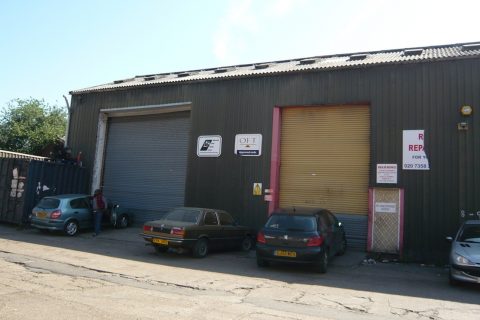From Bermondsey to South Bermondsey, will artists endure forthcoming gentrification?
- Jupiter Woods’ façade with a work. Photo: Emily Jones.
- View of V22’s warehouse on Ilderton Road.
- Views from Cell Projects’ façade on Rollins Street.
- Views of Cell Projects’ studios on Rollins Street .
- View of a studio at Artistic Spaces’ Unit 10, off Juno Way.
- View of a studio at Artistic Spaces’ Unit 13, off Juno Way.
- WW Façade View of Westminster Waste’s façade.
During the 19th Century, Bermondsey was reputed to be one of the roughest areas in London. Its precarious atmosphere was subject to a less than flattering passage in Charles Dickens’ Oliver Twist (1837 – 9), who speaks of its filth, dirtiness and poverty. The industrial boom brought several manufacturers to the area – otherwise characterised by glooming houses – shaping it as a producer of leather and hides at first, and later biscuits. Peek, Frean and Co was established in Dockhead in 1857, moving shortly after to a complex of buildings on Clements Road; their omnipresence in the region led to Bermondsey being dubbed as the ‘Biscuit Town’. During the Second World War, the area – as of the rest of London – was heavily bombed, and a comprehensive revitalisation project came only in the 1980s, due to the London Docklands Development Corporation. The region then started to attract initiatives such as the Delfina Studios, which from 1992 until 2006 (when it became Delfina Foundation and moved into another location) was based in a former chocolate factory on Bermondsey Street, where it hosted 34 studios, an exhibition space and a restaurant. Bermondsey tube station opened in 1999, and the gradual regeneration of the area culminated in the inauguration of White Cube’s largest yet space in October 2011, located also on Bermondsey Street. If on the one hand the opening of the blue chip gallery consolidated Bermondsey’s cultural vocation, it also preluded the end of an era of affordable studios for artists.
One year earlier, the arts organisation V22 had secured a building from the old Peek, Frean and Co complex (inactive since 1989), to host studios for nearly 400 artists as well as a large exhibition space, home to several ambitious projects throughout its short lived existence. In early 2014, the Workspace Group who owned the building sold it to Grosvenor Estates, who renovated it into a series of work and living spaces. One of the clauses of the deal stated that Grosvenor would build a new office complex for Workspace, which is now branded as The Biscuit Factory and offers offices to a broader range of professionals at a much higher rate (their website advertise a 20 square metres studio for £720 per month). About two kilometres west, another creative hub was recently discontinued, leaving hundreds of artists studioless. Since 2010, art organisations like Bermondsey Project, Bow Arts and Tannery Arts provided affordable studios for artists in a complex formed by a few buildings off Willow Walk (the Drawing Room was also located among the complex). Earlier this year, the land was sold and the organisations were forced to leave; Tannery Arts moved buildings and is provisory occupying a neighbouring site where Bow Arts used to be. An artist who has a studio with Tannery since 2011 and moved to this temporary building, explains that they are allowed to stay for longer, but might have to leave with a very short notice.
With new developments popping on a daily basis, it is hard to believe that London still hosts ungentrified secrets like South Bermondsey. Located south of the now posh ‘upper’ Bermondsey and north from the trendy borough of Peckham, the area is characterised by vast warehouses – both empty and in use – and immense council blocks, though largely deployed of local amenities like cafes, dry cleaners or off licences. For a couple of years now, it seems to be embracing a flux of artists who were defeated by the real estate market elsewhere: both V22 and Cell Projects, organisations long committed with providing affordable studios around different locations in London, have a presence in the area. Its art geography further benefits from initiatives such as Artistic Spaces, Jupiter Woods, Penarth Studios and Westminster Waste, all located within one kilometre ratio. V22 has secured an open plan warehouse on Ilderton Road measuring 500 metres for five years, starting in 2014. In that same year, Cell Projects secured a lease on the first and second floors of a former Victorian factory on Rollins Street, building 32 new studios to accommodate over 60 artists. Whereas V22 is a public owned arts organisation and Cell Projects a self funding charity, Artistic Spaces is a company founded in 2010 and present in the area since 2011. They have two spaces off Juno Way, which combined offer 46 studios. Rather than focussing solely on artists, their buildings are occupied also by designers, start-ups and people from the fashion industry. David A. Fox, who joined the organisation in 2011, explains that about 21% of their studios are used by artists (in addition to these two spaces, they have four other venues in South and East London).
Westminster Waste is an independent initiative, started by artists Joshua Sex and Neil Raitt in Spring 2014. Alongside other former RCA students, they had been looking for an empty warehouse to take over for a few months without success. By chance, one of their colleagues eventually came across the bin-men who they now sublet the building from; Westminster Waste is their name, and the artists occupy half of the building. Although they have a rolling agreement, it seems like they will be able to stay there for at least a few years longer. In addition to the studios (about 20, offered at a £10 per square metres rate), they sustain an exhibition space where they host projects with an emphasis on painting and its expanded field. Both them and Fox believe that the area will remain a safe haven for artists for the next few years, but Laura Carew, from Penarth Centre, is well aware of the market forces, and hesitates in giving a long term prediction. An associate lecturer at the Chelsea College of Arts, she started Penarth Studios in 2015 with the aim of creating a centre of excellence and exchange. She tells us that her son, architect Ivo Carew, was cycling around the area one day when he spotted the building; the family then bought some warehouse space, have renovated it and currently offer bright studios for about 23 artists. Sex and Raitt explain that there are plans for another train station at the foot of Rollins Street, which would run as part of the East London line and probably put the area more on the radar – as of now, its transport links with West, Central and East London are quite limited, and it takes at least 20–minute walk from the closest station to any of these studio spaces. This new station would directly affect Jupiter Woods, an exhibition space, residency programme, research and studio space founded in 2014 by a group of students from the Curating programme at Goldsmiths, since they are based exactly where it is planned to function.
Considering its central location and the thirstiness of real estate agents for novelties, we can assume that is a matter of time before South Bermondsey follows the fate of its upper neighbour, or places like Shoreditch and Dalston in the East End. Artists are known for being both a symptom and victims of gentrification, and their presence brings together hipster cafes, organic markets, obscure clubs and, before they even realise, they have been outsmarted by the very circumstances they’ve built. Yet, the government should take harder measures against real estate speculation, instead of leaving the market to dictate housing prices according to its own profit-oriented rules, as it currently does. Even the most orthodox businessmen will agree that a city without the creative energy brought by artists is just plain boring, and on that matter, London is very close to biting its own tail.
November 25, 2020







